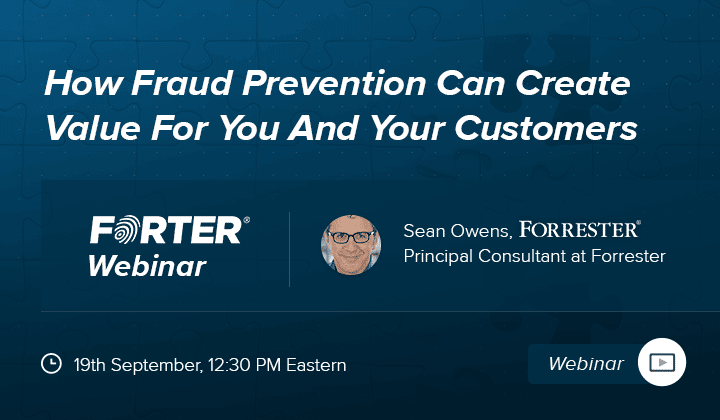For years, online retailers tasked their fraud departments with doing one thing and doing it well: stopping fraud. Recently, a wind of change has been blowing some new perspective into this narrow focus. Stopping fraud is important – but it shouldn’t come at the cost of stopping good sales.
Forrester’s Sean Owens discussed the broad impact of fraud prevention on e-commerce businesses during a webinar led by Aaron Begner, Head of Customer Success at Forter. The chat covered a number of areas of interest in online commerce, from the pressures of providing a smooth customer experience to the rise of mobile and the growth of ecommerce fraud.
Streamlining Checkout – or Choking It
Owens emphasized the integral role that fraud protection plays in the online sales cycle. Since it analyzes customers at checkout, it can help create a smooth, swift shopping experience where the consumer is never even aware they were examined for fraud. Or, alternatively, it can add delay for good customers who have to wait to find out if they will receive their order or, even worse, reject them outright.
A recent Forrester study found that Forter’s real-time decisions for all transactions had a measurable, significant impact on successful sales.
“When you are talking about the fact that you are gaining 1.2 million transactions in the first three years, that adds up to about $10 million in new income,” said Sean Owens. “That is huge and that affects the whole business.”
Those results are based on a Total Economic Impact study, where Forrester analyzes the results of a solution for a number of its clients, and creates a composite merchant which is representative of the total results. This enables other businesses to envision the results they would receive for their own business with greater accuracy and immediacy. You can download a summary of the TEI study here.
False Positives and Lost Revenue
One aspect of fraud protection which Sean Owens spent some time discussing during the webinar was false positives – customers who were wrongly rejected for fraud. As he said, “false positives are the worst result.” That’s because the situation is literally turning away someone who’s at checkout with their wallet out – you’ve rejected a good customer who had made the decision to buy and was trying to do so.
This naturally has a long-term impact, since customers who are turned away are far less likely to come back, compared to customers who have a fast, easy experience. This wasn’t included in the TEI calculation since future business of this kind is hard to estimate accurately, but every business can imagine the effect this metric has on their own revenues.
“We found that once we could analyze our transaction results with Forter, only about 1% of declined transactions were actually fraud; the number of false positives was huge.”
Sales operations specialist, technology retailer
The Forrester study found that Forter’s solution improved false positives dramatically – in fact, by more than 80%. As Aaron Begner noted, this has a measurable impact for customers, both in terms of revenue and in terms of the improved customer support figures. Fewer incorrect fraud decisions means that customers are happier and less likely to call to complain!
Entering New Markets
Owens also touched on another aspect of fraud protection to which many companies pay relatively little attention: entering new markets.
“China is our fastest-growing market; without Forter, there would be no way we could support it.”
General manager, online retailer
This is often the elephant in the room because fraud prevention has simply not traditionally been a part of the conversation of how to enter and make the most of new markets. Many companies are loathe to change the way they think. Yet, the impact of fraud protection on a company’s success in a new market is significant.
Each country has different behavioral norms when its consumers are buying online. A fraud detection system that can’t distinguish these, and use them to determine whether fraud is present or not, will end up rejecting good customers and accepting bad ones. The reason is simple; what’s good behavior in the US might well represent bad behavior somewhere else. If this is something that resonates with you, get in touch – we can help you make sure you become sensitive to different geographies, so that you can promote your business in new markets with confidence.
It’s Not (Only) About Fraud
All of this illustrates the main message of the webinar: the impact of fraud prevention and its success or limitations go far beyond the fraud department. Accepting more customers, improving the customer journey and expanding your market are vital to any business and touch areas which are at the core of a company’s success.
As Sean Owens commented, “Very little of the total benefits are saving in the fraud department.” Setting up your fraud protection in the right way sets the whole business up for success.
To find out more, watch the webinar recording.



